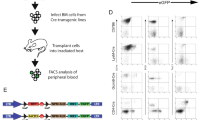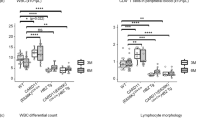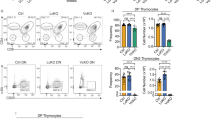Abstract
LYL1, a member of the class II basic helix–loop–helix transcription factors, is aberrantly expressed in a fraction of human T-cell acute lymphoblastic leukemia. Here, we generated transgenic mice ubiquitously overexpressing LYL1 using a construct expressing full-length cDNA driven by a human elongation factor 1α promoter. Four independent lines exhibiting high LYL1 expression were established. Of these transgenic mice, 96% displayed loss of hair with a short kinked tail. Furthermore, 30% of them developed malignant lymphoma, with an average latent period of 352 days. In these mice, histological examination revealed tumor cell infiltration in multiple organs and immunohistochemical analysis showed that the infiltrated tumor cells were either CD3 or CD45R/B220-positive; fluorescence-activated cell sorter analysis indicated that each tumor consisted either of mainly CD4, CD8 double-positive T cells or mature B cells; the clonality of LYL1-induced lymphoma was confirmed by T-cell receptor rearrangement and immunoglobulin heavy-chain gene rearrangement analyses. Mammalian two-hybrid analysis and luciferase assay suggested that excess LYL1 blocked the dimerization of E2A and thus inhibited the regulatory activity of E2A on the CD4 promoter. Reverse transcription-polymerase chain reaction results showed that the expression of certain E2A/HEB target genes was downregulated. Taken together, our results provide direct evidence that aberrant expression of LYL1 plays a role in lymphomagenesis.
This is a preview of subscription content, access via your institution
Access options
Subscribe to this journal
Receive 50 print issues and online access
$259.00 per year
only $5.18 per issue
Buy this article
- Purchase on Springer Link
- Instant access to full article PDF
Prices may be subject to local taxes which are calculated during checkout





Similar content being viewed by others
Abbreviations
- ALL:
-
acute lymphoblastic leukemia
- AML:
-
acute myeloblastic leukemia
- bHLH:
-
basic helix–loop–helix
- CAT:
-
chloramphenicol acetyltransferase
- EF-1α:
-
human elongation factor 1α
- GBD:
-
Gal4 DNA-binding domain
- HDAC:
-
histone deacetylase
- LMO:
-
LIM-domain-only
- MDS:
-
myelodysplastic syndrome
- RT−PCR:
-
reverse transcription-polymerase chain reaction
- TCR:
-
T-cell receptor
- VAD:
-
VP16-activation domain
References
Aplan PD, Jones CA, Chervinsky DS, Zhao X, Ellsworth M, Wu C . (1997). An scl gene product lacking the transactivation domain induces bony abnormalities and cooperates with LMO1 to generate T-cell malignancies in transgenic mice. EMBO J 16: 2408–2419.
Baer R . (1993). TAL1, TAL2 and LYL1: a family of basic helix–loop–helix proteins implicated in T cell acute leukaemia. Semin Cancer Biol 4: 341–347.
Bain G, Engel I, Robanus Maandag EC, te Riele HP, Voland JR, Sharp LL . (1997). E2A deficiency leads to abnormalities in alphabeta T-cell development and to rapid development of T-cell lymphomas. Mol Cell Biol 17: 4782–4791.
Begley CG, Green AR . (1999). The SCL gene: from case report to critical hematopoietic regulator. Blood 93: 2760–2770.
Chervinsky DS, Zhao XF, Lam DH, Ellsworth M, Gross KW, Aplan PD . (1999). Disordered T-cell development and T-cell malignancies in SCL LMO1 double-transgenic mice: parallels with E2A-deficient mice. Mol Cell Biol 19: 5025–5035.
Condorelli GL, Facchiano F, Valtieri M, Proietti E, Vitelli L, Lulli V . (1996). T-cell-directed TAL-1 expression induces T-cell malignancies in transgenic mice. Cancer Res 56: 5113–5119.
Dolcet X, Llobet D, Pallares J, Matias-Guiu X . (2005). NF-kB in development and progression of human cancer. Virchows Arch 446: 475–482.
Ferrando AA, Look AT . (2003). Gene expression profiling in T-cell acute lymphoblastic leukemia. Semin Hematol 40: 274–280.
Ferrando AA, Neuberg DS, Staunton J, Loh ML, Huard C, Raimondi SC . (2002). Gene expression signatures define novel oncogenic pathways in T cell acute lymphoblastic leukemia. Cancer Cell 1: 75–87.
Ferrier R, Nougarede R, Doucet S, Kahn-Perles B, Imbert J, Mathieu-Mahul D . (1999). Physical interaction of the bHLH LYL1 protein and NF-kappaB1 p105. Oncogene 18: 995–1005.
Gilmore TD, Koedood M, Piffat KA, White DW . (1996). Rel/NF-kappaB/IkappaB proteins and cancer. Oncogene 13: 1367–1378.
Herblot S, Steff AM, Hugo P, Aplan PD, Hoang T . (2000). SCL and LMO1 alter thymocyte differentiation: inhibition of E2A-HEB function and pre-T alpha chain expression. Nat Immunol 1: 138–144.
Hjalt T . (2004). Basic helix–loop–helix proteins expressed during early embryonic organogenesis. Int Rev Cytol 236: 251–280.
Hsu HL, Wadman I, Baer R . (1994). Formation of in vivo complexes between the TAL1 and E2A polypeptides of leukemic T cells. Proc Natl Acad Sci USA 91: 3181–3185.
Jones S . (2004). An overview of the basic helix–loop–helix proteins. Genome Biol 5: 226.
Kuo SS, Mellentin JD, Copeland NG, Gilbert DJ, Jenkins NA, Cleary ML . (1991). Structure, chromosome mapping, and expression of the mouse Lyl-1 gene. Oncogene 6: 961–968.
Larson RC, Lavenir I, Larson TA, Baer R, Warren AJ, Wadman I . (1996). Protein dimerization between Lmo2 (Rbtn2) and Tal1 alters thymocyte development and potentiates T cell tumorigenesis in transgenic mice. EMBO J 15: 1021–1027.
Larson RC, Osada H, Larson TA, Lavenir I, Rabbitts TH . (1995). The oncogenic LIM protein Rbtn2 causes thymic developmental aberrations that precede malignancy in transgenic mice. Oncogene 11: 853–862.
Lazorchak A, Jones ME, Zhuang Y . (2005). New insights into E-protein function in lymphocyte development. Trends Immunol 26: 334–338.
Malissen M, Minard K, Mjolsness S, Kronenberg M, Goverman J, Hunkapiller T . (1984). Mouse T cell antigen receptor: structure and organization of constant and joining gene segments encoding the beta polypeptide. Cell 37: 1101–1110.
Massari ME, Murre C . (2000). Helix–loop–helix proteins: regulators of transcription in eucaryotic organisms. Mol Cell Biol 20: 429–440.
Mellentin JD, Smith SD, Cleary ML . (1989). lyl-1, A novel gene altered by chromosomal translocation in T cell leukemia, codes for a protein with a helix–loop–helix DNA binding motif. Cell 58: 77–83.
Meng YS, Khoury H, Dick JE, Minden MD . (2005). Oncogenic potential of the transcription factor LYL1 in acute myeloblastic leukemia. Leukemia 19: 1941–1947.
Miyamoto A, Cui X, Naumovski L, Cleary ML . (1996). Helix–loop–helix proteins LYL1 and E2a form heterodimeric complexes with distinctive DNA-binding properties in hematolymphoid cells. Mol Cell Biol 16: 2394–2401.
Mizushima S, Nagata S . (1990). pEF-BOS, a powerful mammalian expression vector. Nucleic Acids Res 18: 5322.
Murre C, Bain G, van Dijk MA, Engel I, Furnari BA, Massari ME . (1994). Structure and function of helix–loop–helix proteins. Biochim Biophys Acta 1218: 129–135.
Murre C . (2005). Helix–loop–helix proteins and lymphocyte development. Nat Immunol 6: 1079–1086.
O'Neil J, Shank J, Cusson N, Murre C, Kelliher M . (2004). TAL1/SCL induces leukemia by inhibiting the transcriptional activity of E47/HEB. Cancer Cell 5: 587–596.
Robb L, Lyons I, Li R, Hartley L, Kontgen F, Harvey RP . (1995). Absence of yolk sac hematopoiesis from mice with a targeted disruption of the scl gene. Proc Natl Acad Sci USA 92: 7075–7079.
Sakano H, Maki R, Kurosawa Y, Roeder W, Tonegawa S . (1980). Two types of somatic recombination are necessary for the generation of complete immunoglobulin heavy-chain genes. Nature 286: 676–683.
Sawada S, Littman DR . (1993). A heterodimer of HEB and an E12-related protein interacts with the CD4 enhancer and regulates its activity in T-cell lines. Mol Cell Biol 13: 5620–5628.
Shivdasani RA, Mayer EL, Orkin SH . (1995). Absence of blood formation in mice lacking the T-cell leukaemia oncoprotein tal-1/SCL. Nature 373: 432–434.
Toyokuni S, Kawaguchi W, Akatsuka S, Hiroyasu M, Hiai H . (2003). Intermittent microwave irradiation facilitates antigen–antibody reaction in western blot analysis. Pathol Int 53: 259–261.
Toyokuni S, Tanaka T, Hattori Y, Nishiyama Y, Yoshida A, Uchida K . (1997). Quantitative immunohistochemical determination of 8-hydroxy-2′-deoxyguanosine by a monoclonal antibody N45.1: its application to ferric nitrilotriacetate-induced renal carcinogenesis model. Lab Invest 76: 365–374.
van Dongen JJ, Wolvers-Tettero IL . (1991). Analysis of immunoglobulin and T cell receptor genes. Part I: basic and technical aspects. Clin Chim Acta 198: 1–91.
Visvader J, Begley CG, Adams JM . (1991). Differential expression of the LYL, SCL and E2A helix–loop–helix genes within the hemopoietic system. Oncogene 6: 187–194.
Wadman I, Li J, Bash RO, Forster A, Osada H, Rabbitts TH . (1994). Specific in vivo association between the bHLH and LIM proteins implicated in human T cell leukemia. EMBO J 13: 4831–4839.
Wilm B, Dahl E, Peters H, Balling R, Imai K . (1998). Targeted disruption of Pax1 defines its null phenotype and proves haploinsufficiency. Proc Natl Acad Sci USA 95: 8692–8697.
Wilson V, Conlon FL . (2002). The T-box family. Genome Biol 3. REVIEWS3008.
Xia Y, Brown L, Yang CY, Tsan JT, Siciliano MJ, Espinosa III R . (1991). TAL2, a helix–loop–helix gene activated by the (7;9)(q34;q32) translocation in human T-cell leukemia. Proc Natl Acad Sci USA 88: 11416–11420.
Xia Y, Hwang LY, Cobb MH, Baer R . (1994). Products of the TAL2 oncogene in leukemic T cells: bHLH phosphoproteins with DNA-binding activity. Oncogene 9: 1437–1446.
Yan W, Young AZ, Soares VC, Kelley R, Benezra R, Zhuang Y . (1997). High incidence of T-cell tumors in E2A-null mice and E2A/Id1 double-knockout mice. Mol Cell Biol 17: 7317–7327.
Acknowledgements
We thank Dr Robert E Kingston (Department of Molecular Biology, Massachusetts General Hospital) for providing the HEB cDNA clone. We thank Ms Hiroko Saito and Mr Haruyasu Kohda for their expert technical assistance. We also thank Dr Jun Fan for helpful suggestions. This work was supported in part by a grant-in-aid from the Ministry of Education, Culture, Sports, Science and Technology and by a grant from the Inamori Foundation.
Author information
Authors and Affiliations
Corresponding author
Rights and permissions
About this article
Cite this article
Zhong, Y., Jiang, L., Hiai, H. et al. Overexpression of a transcription factor LYL1 induces T- and B-cell lymphoma in mice. Oncogene 26, 6937–6947 (2007). https://doi.org/10.1038/sj.onc.1210494
Received:
Revised:
Accepted:
Published:
Issue Date:
DOI: https://doi.org/10.1038/sj.onc.1210494
Keywords
This article is cited by
-
The transcription factor complex LMO2/TAL1 regulates branching and endothelial cell migration in sprouting angiogenesis
Scientific Reports (2022)
-
Developmental gene networks: a triathlon on the course to T cell identity
Nature Reviews Immunology (2014)
-
The transcription factor Lyl-1 regulates lymphoid specification and the maintenance of early T lineage progenitors
Nature Immunology (2012)
-
Molecular pathogenesis of T-cell leukaemia and lymphoma
Nature Reviews Immunology (2008)



